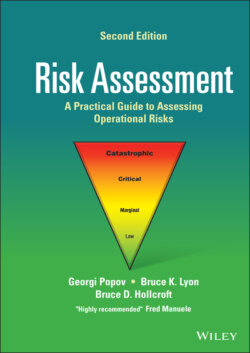Читать книгу Risk Assessment - Georgi Popov - Страница 59
3.8 The Risk Assessment Team
ОглавлениеThe context of the risk assessment assignment will determine the size and makeup of the team needed. The risk assessment team should include a cross‐functional group of individuals who are familiar and knowledgeable with the hazards and operations being assessed. In many cases, the team will be comprised of several members on a consistent basis, while others are likely to come and go based on their ability to contribute to the particular risk assessment. For example, a risk assessment for a production operation might include engineering, maintenance, quality, production, safety, and an operator. A risk assessment for a transportation operation might include a driver, mechanic, and a dispatcher, along with the safety professional. A risk assessment for a product might include a product designer, engineer, legal counsel, production employee, marketing, customer service representative, insurance representative, and safety.
It is important to include members from within as well as outside of the organization that are knowledgeable about the hazards or operations and can make a positive contribution to the risk assessment. In some situations, external members are crucial to an assessment. During the “Occupy Movement” in 2011, a risk assessment was being performed for emergency planning purposes at a company near the Port of Oakland, California. The company did not have a security person and it was recommended that the security firm for the complex be invited to participate. As a result, the outside security professional identified that the Port was subject to civil unrest during the risk assessment. Recommendations from the assessment were addressed. Soon after “Occupy Oakland” occurred disrupting operations, but the company was prepared as a result of the input from the external security person.
A facilitator is also an important member of the risk assessment team. The facilitator could be an additional member or one of the members who is knowledgeable about the hazard or operation. The facilitator must know the risk assessment process and techniques. They must also understand the purpose and scope and be able to communicate this to the other members in order to keep them focused and on track. The facilitator should be confident but not controlling. Confidence is important to keep the risk assessment progressing in the right direction, staying objective, and on a reasonable schedule. However, the facilitator must avoid being controlling or dominating and should prevent other team members from dominating the risk assessment. Each member should feel comfortable contributing their ideas to the risk assessment and be assured that their contributions will be valued. The facilitator is key to the success of a good risk assessment.
A risk assessment team of about three to 10 members seems to work well. Less than three members may not provide enough perspectives or insights into the risk assessment. Risk assessment teams with more than 10 members may be difficult to control and keep focused. At some point a large risk assessment team will likely be dominated by some of the stronger personalities. The facilitator must function so as to avoid this situation.
A team that is committed performs the best and most thorough risk assessments. To be committed, the team must understand the purpose, scope, and the value of the risk assessment. They must be informed and understand how the risk assessment will contribute to the organization’s goals and objectives. They should have the support of their manager and understand that a certain amount of prestige is associated with being on the team. A good facilitator can solicit a great deal of commitment out of team members though good communication on these matters.
The risk assessment team should have the appropriate skills to perform a successful risk assessment. They should understand the basic risk assessment concepts and methods. They can learn these concepts and methods through experience over time, or they can be provided basic instruction immediately prior to the risk assessment. They should be clear on the purpose and scope of each individual risk assessment. This includes knowing why the risk assessment is being performed and how the information will be applied and used. This communication should be clear and concise, and the facilitator should provide it or make sure it has previously been provided. Good communication and skills are essential.
